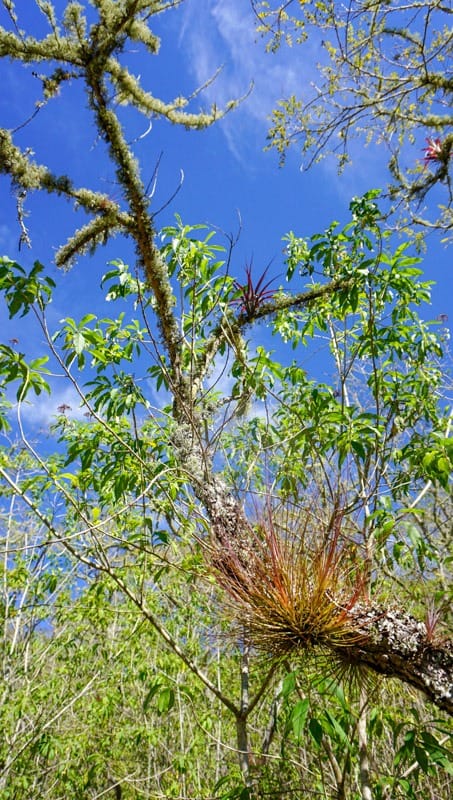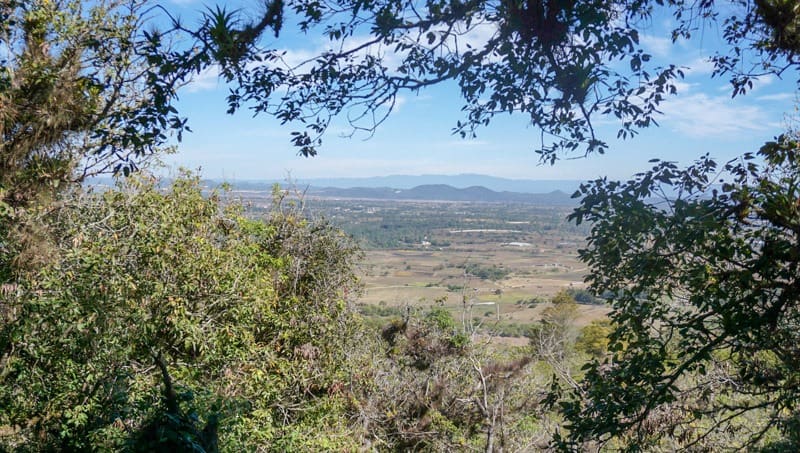One of the reasons why we love Chiapas, Mexico is the abundance of archeological ruin sites. In the northern part of the state, you can find two incredible sites: Palenque and Yaxchilan. And in the southern region, there are quite a few more.
Tenam Puente is an archeological ruin site located just outside of the city Comitan. Its name literally translates to “defensive bridge,” and it served as a major trade hub for nearly 1,000 years. The significance of this site continues to this day with the local people continuing to make annual an annual pilgrimage. The site has three ball courts and three distinct plazas spread out over different levels. It’s situated in the dry prairie region which has been selectively cleared, so much of it is still filled with vegetation.
Take a few hours away from the main tourist crowds and make your way out to Tenam Puente ruins. Climb the pyramids, connect with the past and current people, and enjoy the beautiful scenery all around it.
History of Tenam Puente
Comitan can serve as an excellent home base for exploring the southern area of Chiapas. We’ve already written about the melting Lagartero ruins near Lagos de Colon. And if you’re heading out to Lagos de Montebello, you should consider stopping at the Chinkultic ruins.
But our favorite day of exploration in the area involves two sites: El Chiflon waterfalls and the ruins at Tenam Puente. The site was founded sometime between 300 B.C. and 300 A.D., developed between 300 A.D. and 600 A.D., and inhabited until 1200 A.D. The structures are spread over nearly 10 acres.
This site’s importance was rooted in its ability to serve as a major trade hub. People from the south in what is now Guatemala would pass through in order to trade with people living in what is now Chiapas, Oaxaca, and other ancient civilizations rooted in the northern area of the Maya world.
The first description of Tenam Puente ruins is credited to Franz Blom and Oliver the Forge, dating back to 1925. (Na Bolom Museum in San Cristobal de Las Cases provides excellent details about the life of Franz Blom and his wife who were some of the earliest modern explorers to the region.) Surprisingly, the first systematic investigations of the site did not occur until 1992!



➡️ Visiting Chiapas? Check out the Ultimate Chiapas Travel Guide for everything you need to know!
How to Get to Tenam Puente Ruins
From Comitan, this site is a mere 30 minutes away. There are colectivos (combi vans) running from the city center directly to Tenam Puente for $20 pesos ($1 USD) per person. They leave regularly (about every hour or so) and can be found at 2a. Avenida Pte. Sur 21, Centro, 30000 Comitán de Domínguez, Chiapas (GPS coordinates: 16.249561, -92.136765). The vans for Lagos de Montebello are right next door.
The Tenam Puente Ruins’ entrance fee is $40 pesos ($2 USD) per person, which provides access to a small museum and the entire ruin area. There are no stores and no vendors on-site, so make sure to bring some water and snacks.
After buying the ticket, there’s a short walk down to the gate where you’ll be greeted by a security guard. Backpacks must be checked with the guard and cannot be brought into the site. No food, tripods, or drones are allowed past the gate (like most INAH locations), but you can bring in your camera, water, and sun protection (hats, shirts, sunscreen). For more information on what to bring to archeological ruin sites in Mexico, check out our full post on it here.

Entrance to the Site: Ball Court, Plaza A, & Building Number 7
Walking up past the gate, you’re at the lowest level of the entire site and will encounter the first ball court. If you aren’t familiar, these courts have rules that are a sort of soccer/basketball crossover: there are two small hoops that each team is trying to put the balls through, and you can hit the ball with anything except your hand. The game held spiritual significance as well as general sport. Sometimes leaders would use the games to resolve disputes as well.



From the lower court, you’ll climb the first set of about 20 steps – taking you to the main, leveled area of the ruin site. Directly in front of you is Edificio 11 (Building 11), which is a medium-sized standalone pyramid. Wrap around it to the left and you’ll find the tallest pyramid of the site, Edificio 7 (Building 7). You can climb to its approximately 75-foot high top for great views all around. The steps are very steep, so make sure to zig-zag left and right while going up to keep your entire foot on the step.

Central Area of Tenam Puente: Plaza B
Walking back toward the middle of the site, you’ll find the other, larger ball court and a central area with many structures around it. The northern building (Edificio 17) is thought to be the main temple. It’s likely that the elders and spiritual leaders of the civilization congregated here.
From 300 to 1200 A.D., the leaders of the civilization would gather and rule from this section of town. As many civilizations nearby fell, the importance of Tenam Puente continued due to its favorable location as a trade hub.


Modern Spiritual Significance
Tenam Puente has one very special aspect: not only is this a site of spiritual significance for the ancient population that inhabited the area long ago, but it is also important to the local community to this day.
As you wrap around Building 17, you’ll find a smaller temple (Edificio 14) with white cross sticking up out of the ground. This is the Cruz de Madera (Cross of Wood). No, this wooden cross has not somehow persevered through hundreds of years. It is a marker set in place by the current population to signify the spiritual significance the area still holds. Crosses have been used in indigenous cultures here for a long time, even before exposure to Christianity.



Each May, the local people come to this exact cross within the site of Tenam Puente to pray for a good rainy season and harvest. This is an important ceremony for the community as they rely heavily on agriculture in order to maintain a living.
Then in August, there is a major pilgrimage and celebration held here. People, mainly part of the Tojolabal group, come from all around to enjoy food, drinks, and fireworks given as offerings to thank the gods for the life and harvest provided.

Plaza D: Avocado Trees, Aggressive Ants, and Another Ball Court
Once done there, you can wrap around toward the right (southeast) to find a very wide structure with three separate staircases. This is known as Edificio 42. This imposing structure speaks to the ability of the people at Tenam Puente to build quite large structures meant to house many people.
There is a large avocado tree here, packed to the brim with fresh avocados. They were practically covering the ground when we visited.

And nearby is a mound of very aggressive ants. I managed to stand on top of their mound while taking photos. Needless to say, it was not enjoyable. They swarmed my legs and continued biting for about ten minutes after I realized my mistake. So take it from me, watch where you step!
Once done there, you’ll keep wrapping around the site, passing the last ball court, until you make your way back to the beginning point. You might notice a couple of trails leading into the brush, but there is no need to dive in; they just wrap around to the entrance.


Tenam Puente Ruins Summary
The ruins near Comitan are plentiful, and the Tenam Puente site is great since there are few people, the site is large, and you can climb all over them. Take a few hours out of a day near Comitan and make sure to squeeze them in. They make for a great addition to a day trip of seeing the Cascadas El Chiflon.
Have you seen other sites that blend an ancient spiritual location with one that’s still currently significant? Leave a comment below to let us know where!
Like This Post? Pin It!




